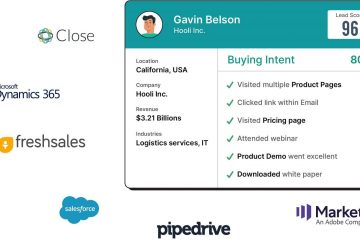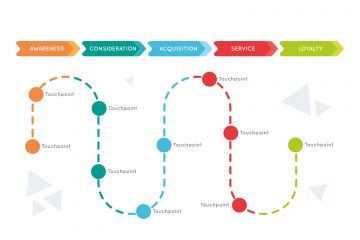What Is Speed To Lead? How Can You Improve It?
Updated on July 1st, 2024
When an ideal prospect fills out a form on your website either to enquire for information or to get a free trial/demo, they are clearly indicating that they are interested in your offering. In other words, these high-intent leads are primed for conversion. However, many B2B businesses fail to recognize the importance of a quick response time.
Research indicates that responding within five minutes of an inbound prospect becoming a lead can be 21 times more effective than responding in the next 30 minutes. What does this mean? It indicates that converting more customers in today’s fiercely competitive business environment is a race against time. A fast response time can, thereby, make all the difference between your company establishing itself as a market leader and struggling in the backwaters.
However, most B2B organizations do not do enough when it comes to contacting their inbound prospects quickly. This has led to the rise of the term “speed to lead”. The average speed to lead of a B2B business is 42 hours. That is shocking! Moreover, only about 27% of inbound leads ever get contacted. Each of these statistics underline the same issue—businesses are leaving a lot of potential revenue on the table because they don’t adequately prioritize speed to lead.
If this resonates with you and you would like to increase your response time toward inbound leads, then you should definitely read this blog. In this article, we will give you an overview of what speed to lead is, why it matters, and strategies you can use to improve this metric and close more sales and revenue each quarter.
Let’s get started!
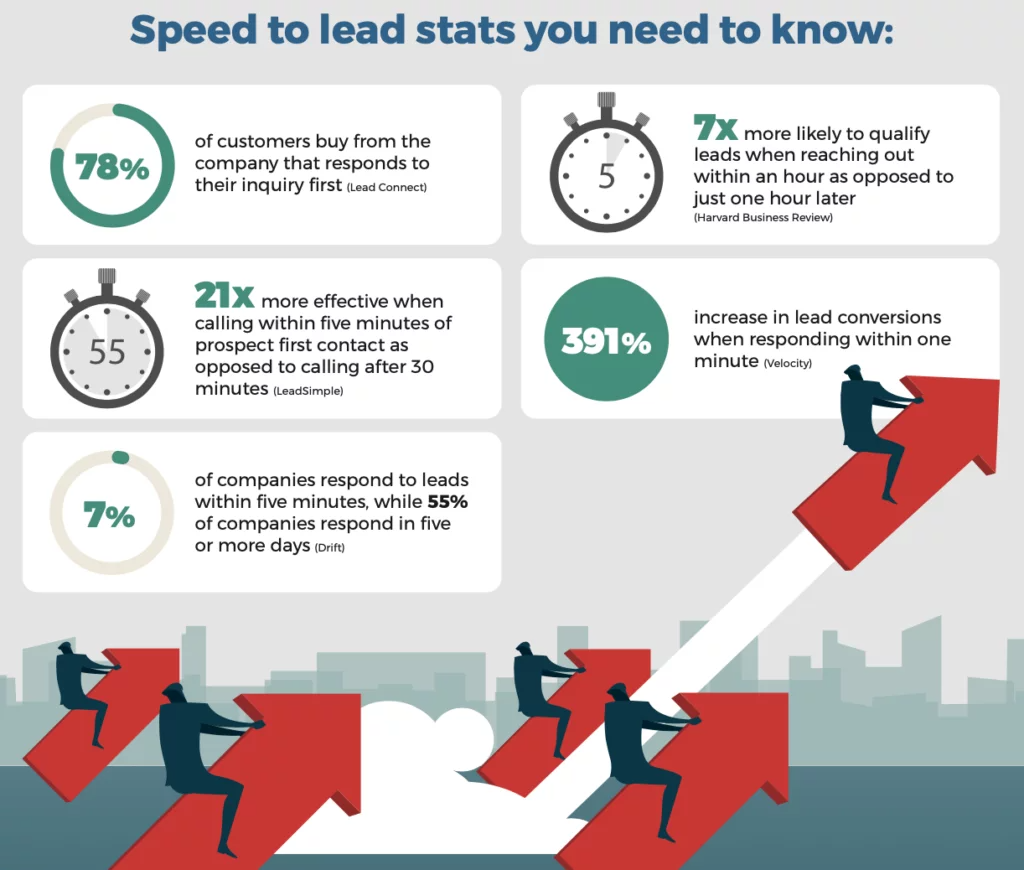
Infographic Source: LeanData
What is Speed To Lead?
Speed to lead is referred to as the pace at which your company responds to a qualified prospect from the moment they become an incoming lead.
Let’s explain this with an example. Suppose your company sells a subscription to a productivity tool and a website visitor has filled in your contact form on one of your landing pages. In response, you sales rep sends them an email or calls them in the next ten minutes. This means your speed to lead time is ten minutes.
While the exact moment a prospect turns into a lead varies depending on the organization, it usually happens when the prospect submits a contact form or requests a demo.
It is important to note here that no communication channel should be given preference over another. In other words, speed to lead refers to the amount of time it takes for a company to reply to a lead, regardless of the channel they approach the business through, including phone, email, web contact form, social media, etc.
Now, let’s understand how your speed to lead impacts sales.
How Does Your Speed To Lead Impact Sales?
For inbound prospects, time is of the essence. Consumers have thousands of options at their fingertips, which means they wouldn’t hesitate to move their business to your competitor’s doorstep if you do not contact them within the “golden window” after their first interaction with your brand. In fact, when businesses respond to a lead within five minutes, they are nine time more likely to achieve a conversion!
The ideal response time in case of an inbound lead is five minutes. This may sound like a no-brainer, right? However, a surprising number of salespeople fail to capture such high-intent inbound leads in their nets. Moreover, a slow speed to lead acts like a warning to potential customers about an impending bad customer experience. They begin wondering: If this is how it seems at the initial point of contact, what will happen once they become paying clients? When an emergency arises, how long will it take the customer service team to respond?
This is why speed to lead—a metric gauging how long it takes for sales to make the initial contact—has gained widespread use among sales teams.
Now, let’s take a quick glance at the benefits of instant speed to lead for sales.
Benefits of Speed To Lead For Sales
Responding quickly to incoming leads sends a message—that you are serious about your sales efforts and would like to provide potential customers with a compelling brand experience.
Besides this, here are some other benefits of an instant speed to lead:
1. Increase in Conversion Rates
Prompt follow-up with leads can increase the likelihood of conversion. Studies show that contacting a lead within one minute can boost the chances of successful conversion by 391%.
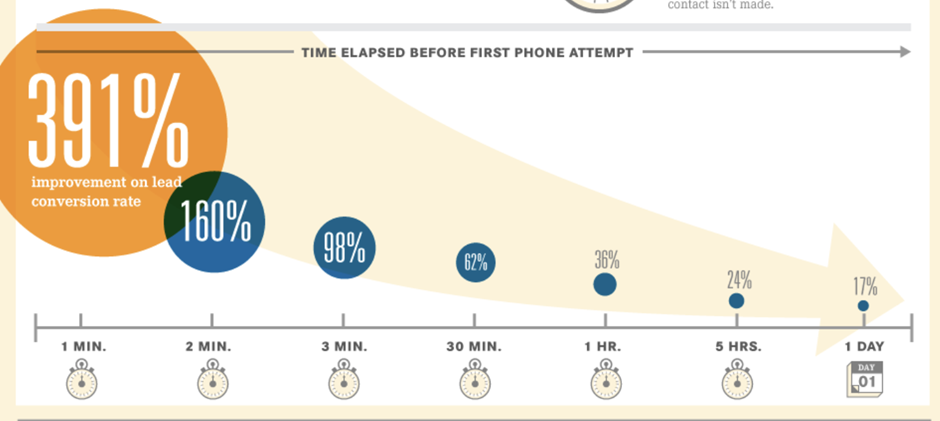
You can achieve optimal speed-to-lead times of five minutes or less by using intelligent call routing, email, and SMS automation. Demo request buttons can also be optimized by businesses to convey prospect details to the appropriate salespeople and initiate a sales SMS instantly. Other effective methods to engage leads quickly include live chat, chatbots, demo requests, scheduling calls, and popup calls to action.
2. Improved Lead Quality
Faster follow-ups strongly correlate with higher lead quality. Having a conversation with leads during their prime interest period ensures that it is timely and relevant, thereby increasing the likelihood of a successful sale.
In fact, businesses that got back to prospective clients within an hour of getting a question were almost seven times more likely to qualify the lead than those those that took longer than an hour to respond. Therefore, a faster speed to lead improves your chances of netting more high-quality leads with an urgent need and an appropriate budget to invest in your products or services.
3. Enhanced Sales Process Efficiency
Responding instantly to your leads can create a lasting impression of proactiveness upon your potential customers, building trust and enhancing the customer experience. Thus, a quicker speed can significantly optimize sales process efficiency.
One way to increase your speed to lead is to align marketing and sales. Establishing precise expectations and response times for various lead types is also essential. Furthermore, implementing systems for lead routing, progressive dialing, and email automation can also assist in managing and prioritizing leads without compromising personalization.
4. Boost in Sales Numbers
With increased conversion rates and enhanced sales process efficiency, it is no surprise that a faster speed-to-lead boosts sales numbers.
Responding to leads quickly is critical to lead nurturing since it guarantees ongoing interaction even with non-purchasing leads. In fact, studies show that following up with leads seven or more times can increase trust in customer relationships by 15%. Thus, reducing response times through an automated lead delivery process can significantly increase sales opportunities.
5. Greater Competitive Marketplace Advantage
Lastly, speed to lead can be a key differentiator in competitive markets. Research indicates that more than 55% of businesses have a lead response time greater than five days.
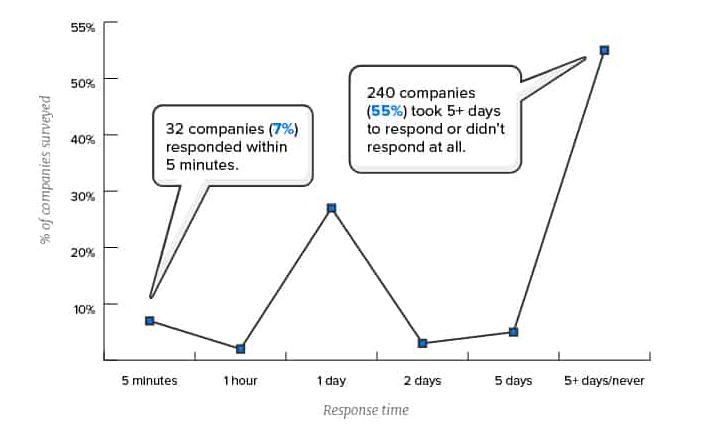
Image Source: Drift
This means that if you increase your speed to lead times, you are already ahead of half of your competitors. Being the first to respond can prevent competitors from engaging with the same lead, effectively capturing potential business opportunities before others have a chance. Prompt follow-ups also elevate brand recognition as it shows customers that their time and needs are valued by your business, thereby creating a positive brand reputation.
So, is your speed to lead optimal? If not, let’s find out the possible reasons.
Why Your Speed To Lead May Not Be Optimal?
We assume that by now, you have already measured your speed to lead. If you find it lacking compared to industry standards, we can help you troubleshoot. One of the simplest reasons could be a lack of data!
The simple reason is a lack of (guess?)… data!
Without manual investigation, leads cannot be scored, prioritized, and organized in an orderly manner, ready to be dropped in the hands of the appropriate sales representatives, because they do not always arrive with all the context!
Businesses, in general, receive a name, email address, and information from one or two additional form fields (if you are lucky!). To improve the likelihood of conversion, forms should frequently demand a minimum amount of data. People frequently just want to get through forms, so even if your form has mandatory fields, there’s no guarantee that the information they enter will be accurate. Thus, information beyond the name and email must also be validated, consistent, and the subject of additional study.
Without the right data, you can be forced to rely on manual investigation and lead qualification. Many salespeople squander time attempting to find out information such as the prospect’s location, the name of the organization, and whether the account is a suitable fit, before they can send an email or pick up the phone to call a prospect. Consequently, the speed to lead time increases considerably.
In an ideal scenario, a salesperson would be receiving the leads they would have to follow up on, neatly profiled, scored, verified, and prioritized. However, achieving it manually while trying to maintain a quick response time can be next to impossible. This is where a lead qualification tool like Salespanel can be very helpful (more on that later!).
Also, Salespanel’s Account Reveal feature can help you immediately identify and prioritize accounts visiting your website even before they sign up!
In the following section, we will highlight seven strategies that can help you improve your speed to lead.
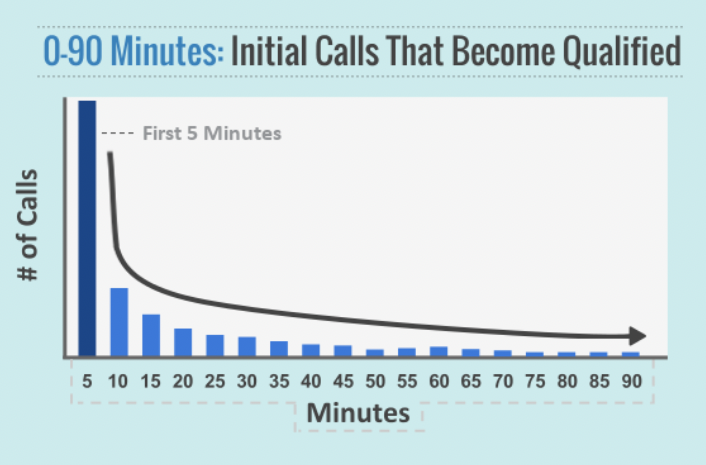
Image Source: Chili Piper
Strategies To Improve Speed To Lead
Now that you know what speed to lead is and how important it is for your conversions, let’s check out these seven practical tips to increase speed to lead for your business:
1. Automate Lead Scoring and Qualification Based on Recent Activities for Prioritization
Lead scoring can help your sales representatives can identify which leads have a higher intent for purchase. However, scoring each lead manually, especially for a scaling business, does not make sense. This is where automated lead scoring comes in.
Your sales representatives can decidedly increase their speed to lead times with automated lead scoring since they can spend more time speaking with prospects rather than going through a list of fresh leads. By determining the prospect’s engagement level instantaneously, automated lead scoring and qualification based on past activities shorten the time it takes to convert a prospect into a lead. Automated lead scoring and qualification tools like Salespanel, Hubspot, and Madkudu facilitate real-time scoring and prioritization based on recent interactions, like website visits, social media engagement, and email replies. This guarantees that highly qualified and engaged prospects are quickly found and given attention on a priority basis.
Salespanel offers four functions on its lead qualification platform:
- Lead Segmentation: To qualify leads based on demographic, firmographic, and behavioral data attributes.
- Lead Scoring: To assign marketing-qualified leads with a sales-ready score based on data points, such as lead source, company size, lead’s job role, page visits, email opens, etc., and predictive analysis.
- Data Sync: To find prospects with high intent for purchase and establish first-touch communication in a relatively short amount of time (directly improving speed to lead)
- Data Export: To easily export leads to spreadsheets, CRM, or email marketing tools through customized lead export workflows on autopilot..
If you want an automated lead qualification tool that helps you enhance your speed to lead time, check out Salespanel today!
2. Route Leads Geographically
If your business caters to businesses globally, it would mean that your inbound leads may be coming from several different time zones.
This can drastically affect your speed to lead times. For example, if your company is US-based, and your sales rep notices a sales demo request from an inbound lead from the West Coast at 10 AM EST, they will probably respond to them instantly. However, if the same request comes from a customer situated in India at 10 AM IST, it could take your sales team several hours before they respond to it, owing to the time difference. Not to mention, they might miss it altogether, buried under several other demo requests the next morning.
Thus, to improve your speed to lead time, you can try to route leads to representatives operating in the same time zone. It will not guarantee that you respond more quickly, but it will at least provide your representatives a greater opportunity to react.
3. Route Leads Based on the Strengths of Sales Reps and Areas of Specialization
If a new lead resembles an old one, a sales representative who has been successful in converting leads of a particular kind—based on factors like job title, industry, or company size—may be more likely to reply to it and do so more quickly.
For instance, let’s imagine you help STEM professionals manage their productivity with your proprietary software. If a salesman in your business has a STEM background or has some experience dealing with productivity issues in a company, you should enable them to convert that lead.
The speed to lead time for a sales representative may considerably be sped up if leads are assigned to them based on the industry they are more prone to dealing with. Every sales rep has their strengths. You should try to assess the strengths of your reps (as well as their shortcomings) in light of this, and then use your newfound understanding to create workflows that direct particular kinds of leads to specific sales reps.
4. Assign Marketing To Co-Own Leads
In the digital era, converting leads is no longer the sole responsibility of sales teams; it belongs to everyone on the revenue operations team—and that includes marketers!
Speed to lead times can be accelerated by assigning marketing to co-own leads, which encourages communication between the marketing and sales departments. Leads move from marketing to sales with ease when both teams take joint responsibility for them. The sales team can take swift action, thanks to the insightful information and context regarding a lead’s engagement history and preferences, provided by the marketing team—and the results are often rewarding! Research indicates companies that align their sales and marketing departments generate over 208% more revenue.
Buyer-focused content may effectively persuade and convert hesitant prospects into paying customers, whether it’s for lead generation, addressing customer concerns, or upselling consumers who are ready for an upgrade. This cooperation between sales and marketing guarantees faster alignment, minimizes lead follow-up delays, and improves the speed to lead time overall. Organizations that practice effective communication and shared accountability are better able to seize opportunities quickly, which leads to higher customer satisfaction and faster conversion rates.
5. Determine Drop-Off Points in Your Customer Journey
The customer journey can be long, especially when the industry is B2B. B2B transactions, in general, include multiple stakeholders and several touch-points, which brings us to this point. It is essential to track your customer journey and determine drop-off points, especially for high-intent leads.
Monitoring your team’s performance to keep tabs on their progress towards lead conversion efforts at a faster pace and devising plans to enhance lead response time are paramount. The speed at which your sales representatives respond to leads and the conversion rates they achieve can be seen in a lead response time sales report. Additionally, this will also help you identify patterns of friction or drop-off areas to help you optimize your workflows.
Reporting basically involves figuring out how long it took to create your lead and follow up using a straightforward formula. You can now use this information to compare performance to historical data, average it across your sales force, or determine the speed at which individual reps work and then look for ways to keep improving it.
6. Optimize Your Landing Pages To Encourage Prospects To Sign Up as Leads
When it comes to conversion rate optimization, your landing pages are valuable real estate. If you are not doing your best to engage prospective website visitors the minute they land on one of your landing pages, are you really doing enough to improve your speed to lead time?
You can use these tips to optimize your landing pages:
- Make sure your landing page has an obvious call to action (CTA). Your call to action (CTA) instructs potential customers on what to do next. A distinct CTA directs potential customers to convert.
- Make your lead forms as good as possible. Make sure they are simple to fill out your forms. Run A/B tests on your forms to find out which little adjustments result in higher conversion rates.
- Use heatmaps to understand how users interact with your landing page. Do people who visit your website browse down the page and click on your calls to action? Heatmaps show you whether site visitors click on your CTAs or complete your forms.
- Think about other opportunities to engage your website visitors, such as introducing live chat, demo requests, product tours, and popup reminders. The idea is to make your brand as accessible and interactive as possible, thereby, reducing friction.
7. Explore Chatbots, Email Automation, and Self-Service Product Demos for Conversion
Stemming from the previous point, there are several avenues you can explore to improve your speed to lead times. For instance, your sales representatives don’t have to write original emails and follow up with leads every day to increase response frequency. Martech tools like chatbots, email automation, and self-service product demos can also help you improve your speed to lead times, by helping you build automated workflows.
Email automation and chatbots can help your sales representatives respond to leads more quickly, which will increase customer satisfaction. For scheduling demos, you can use a meeting scheduling application like Calendly and create a self-service appointment booking procedure to facilitate easy access for potential customers. To make sure your lead hears from you right away, you should, however, make sure your workflow sends an email confirmation and reminder about your appointment!
Final Thoughts
In today’s technologically advanced climate, the least businesses can do is reply to leads promptly. Using the strategies highlighted above, you may achieve great results. However, it is important to remember that no matter your speed to lead time can always be improved.
Studies have consistently shown that the faster you qualify and respond to a lead, the more likely they are to invest in your product or service as a long-term customer. As evidenced above, lead qualification and prioritization can take up a significant amount of time. This means that using a tool for automating these processes is super important and can reduce your speed to lead times rapidly.
Sell more, understand your customers’ journey for free!
Sales and Marketing teams spend millions of dollars to bring visitors to your website. But do you track your customer’s journey? Do you know who buys and why?
Around 8% of your website traffic will sign up on your lead forms. What happens to the other 92% of your traffic? Can you identify your visiting accounts? Can you engage and retarget your qualified visitors even if they are not identified?
